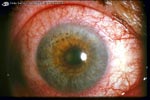Uveitis is an inflammation that affects a part of the eye called the uvea. The uvea provides most of the blood supply to the retina. Uveitis causes spotty areas of scarring that can lead to vision loss.

The degree of vision loss depends on the amount and location of the scarring. Uveitis is responsible for approximately 10% of the blindness in the United States.
Symptoms
- Red eyes
- Blurred vision
- Sensitivity to light
- Dark, floating spots in the vision
- Eye pain
- Intraocular pressure that is higher than normal
Causes
Many conditions, diseases and infections can lead to the development of uveitis. In some cases the cause is unknown. Uveitis usually affects people between 20-50 years of age.
Diagnosing Uveitis
Uveitis is diagnosed with a thorough internal examination of the eye. Near and distance vision, plus intraocular pressure are also evaluated. In some cases, blood tests are performed to check for underlying disease or infection.
Treating uveitis
The appropriate treatment for uveitis is determined by the severity of the disease and which eye structures are involved. Uveitis is typically treated with topical eye drops and/or oral medications to reduce inflammation. Sometimes, medication is required to lower the intraocular pressure, too. If complications are advanced, surgery may be necessary.
After the inflammation has gone down, such as scar tissue, cataracts and glaucoma that have resulted from uveitis may need to be treated.



